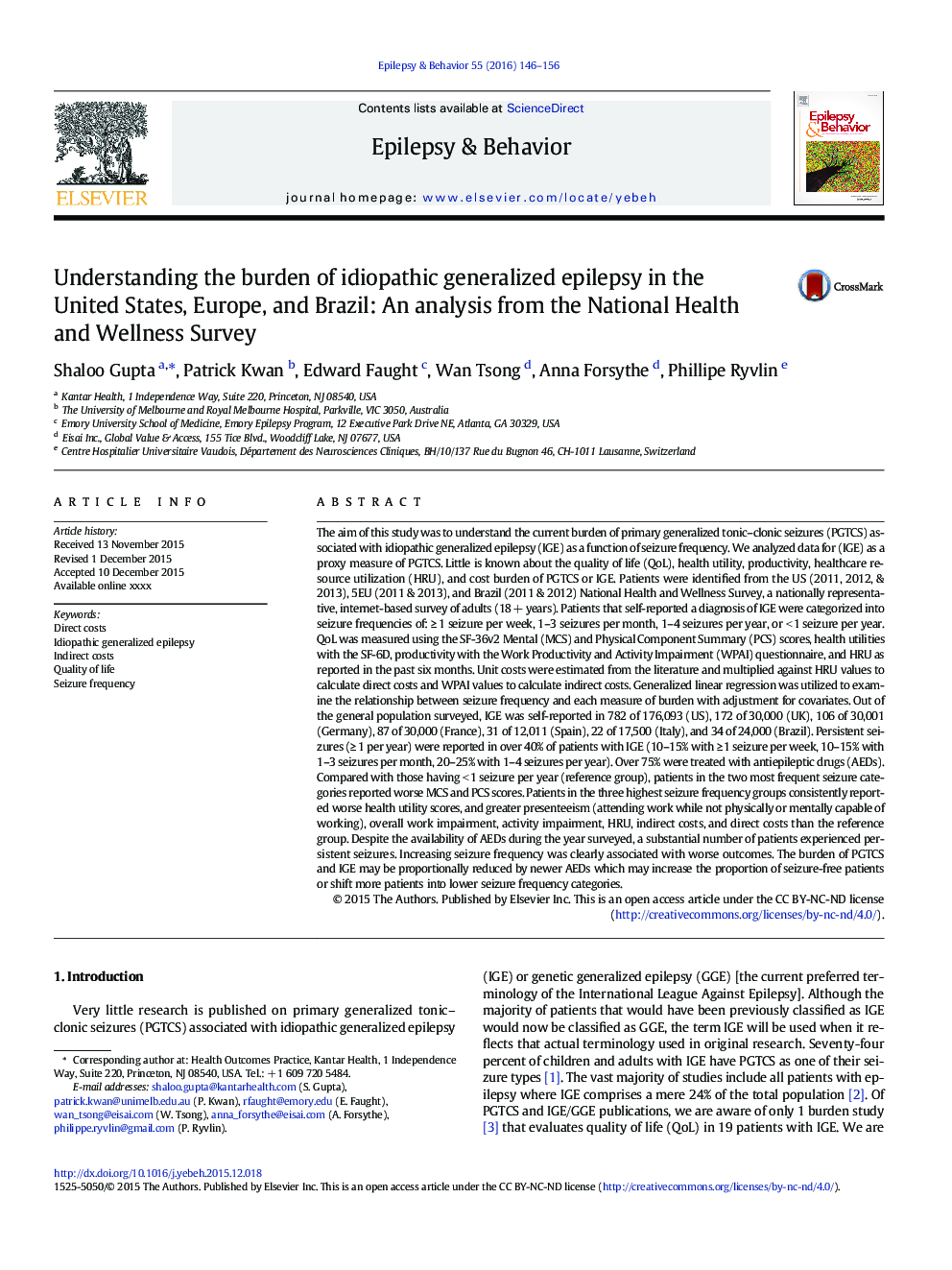| کد مقاله | کد نشریه | سال انتشار | مقاله انگلیسی | نسخه تمام متن |
|---|---|---|---|---|
| 6010710 | 1579835 | 2016 | 11 صفحه PDF | دانلود رایگان |
عنوان انگلیسی مقاله ISI
Understanding the burden of idiopathic generalized epilepsy in the United States, Europe, and Brazil: An analysis from the National Health and Wellness Survey
ترجمه فارسی عنوان
شناخت بار کلیوی صرع عمومی در ایالات متحده، اروپا و برزیل: تجزیه و تحلیل از نظرسنجی ملی سلامت و سلامت
دانلود مقاله + سفارش ترجمه
دانلود مقاله ISI انگلیسی
رایگان برای ایرانیان
کلمات کلیدی
موضوعات مرتبط
علوم زیستی و بیوفناوری
علم عصب شناسی
علوم اعصاب رفتاری
چکیده انگلیسی
The aim of this study was to understand the current burden of primary generalized tonic-clonic seizures (PGTCS) associated with idiopathic generalized epilepsy (IGE) as a function of seizure frequency. We analyzed data for (IGE) as a proxy measure of PGTCS. Little is known about the quality of life (QoL), health utility, productivity, healthcare resource utilization (HRU), and cost burden of PGTCS or IGE. Patients were identified from the US (2011, 2012, & 2013), 5EU (2011 & 2013), and Brazil (2011 & 2012) National Health and Wellness Survey, a nationally representative, internet-based survey of adults (18 + years). Patients that self-reported a diagnosis of IGE were categorized into seizure frequencies of: â¥Â 1 seizure per week, 1-3 seizures per month, 1-4 seizures per year, or < 1 seizure per year. QoL was measured using the SF-36v2 Mental (MCS) and Physical Component Summary (PCS) scores, health utilities with the SF-6D, productivity with the Work Productivity and Activity Impairment (WPAI) questionnaire, and HRU as reported in the past six months. Unit costs were estimated from the literature and multiplied against HRU values to calculate direct costs and WPAI values to calculate indirect costs. Generalized linear regression was utilized to examine the relationship between seizure frequency and each measure of burden with adjustment for covariates. Out of the general population surveyed, IGE was self-reported in 782 of 176,093 (US), 172 of 30,000 (UK), 106 of 30,001 (Germany), 87 of 30,000 (France), 31 of 12,011 (Spain), 22 of 17,500 (Italy), and 34 of 24,000 (Brazil). Persistent seizures (â¥Â 1 per year) were reported in over 40% of patients with IGE (10-15% with â¥Â 1 seizure per week, 10-15% with 1-3 seizures per month, 20-25% with 1-4 seizures per year). Over 75% were treated with antiepileptic drugs (AEDs). Compared with those having < 1 seizure per year (reference group), patients in the two most frequent seizure categories reported worse MCS and PCS scores. Patients in the three highest seizure frequency groups consistently reported worse health utility scores, and greater presenteeism (attending work while not physically or mentally capable of working), overall work impairment, activity impairment, HRU, indirect costs, and direct costs than the reference group. Despite the availability of AEDs during the year surveyed, a substantial number of patients experienced persistent seizures. Increasing seizure frequency was clearly associated with worse outcomes. The burden of PGTCS and IGE may be proportionally reduced by newer AEDs which may increase the proportion of seizure-free patients or shift more patients into lower seizure frequency categories.
ناشر
Database: Elsevier - ScienceDirect (ساینس دایرکت)
Journal: Epilepsy & Behavior - Volume 55, February 2016, Pages 146-156
Journal: Epilepsy & Behavior - Volume 55, February 2016, Pages 146-156
نویسندگان
Shaloo Gupta, Patrick Kwan, Edward Faught, Wan Tsong, Anna Forsythe, Phillipe Ryvlin,
